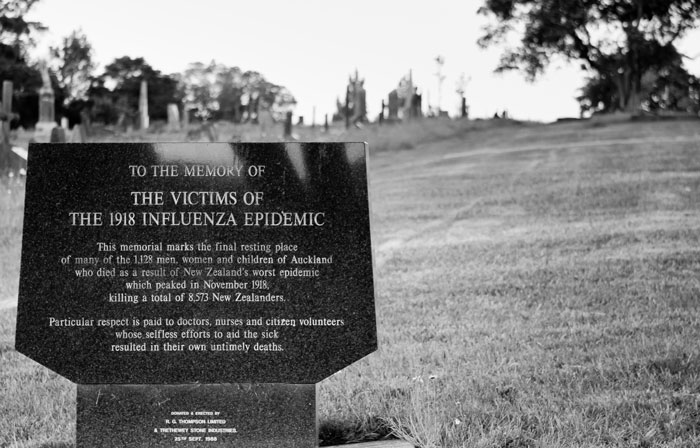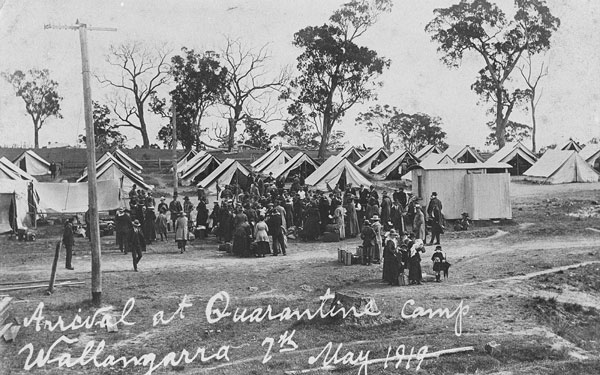Maclean didn’t escape in 1919, as we have seemed to this time in 2020 – while many soldiers had suffered influenza while serving overseas, they also were responsible for spreading the Spanish ‘flu as they came home over the six months after the Armistice – just as our COVID –19 arrived with people returning from overseas trips by air or sea.
It was in December 1918 that the first note from the Department of Health was tabled at a Maclean Council meeting. Here they were warned of the “danger of pneumonic influenza, and the detailed equipment needed for an inoculation depot”, Council was urged to try to secure the required equipment, but not to go to any expense until the disease arrived in the district.
By the end of January 1919, the councils of Maclean and Harwood met to form a committee to deal with the impending disease. February 10th 1919, the Daily Examiner reported that hypodermic needles were in hand and the secretary of the Committee recently elected to organise the response to the ‘flu, Mr Stuart Maurice, had received a supply of the vaccine from Mr Smith, manager of the Harwood Mill. An inoculation depot was to be set up in the Maclean council chambers.

By February 1919 the news included the following ‘facts’:
- The number of cases in Victoria had reached over 1600.
- Smoking was permitted in Melbourne courts as a preventative of pneumonic influenza.
- The Minister of Health appealed to the “sporting sense” of the people to wear masks. “if they do not respond, other methods should be employed.”
- The Federal Government “is desirous that all Queenslanders at Tenterfield should return to Sydney and then proceed home by water.”
- A public meeting at Byron Bay protested the arrival of passengers by sea or land from Sydney during the pandemic.
- Queensland was still ‘clean’. A quarantine station was set up at Tweed Heads.
- The State Government called for hotels, theatres, bands, picture shows etc be closed. There was also a call for relief for those whose jobs were lost.
- In Maclean, instructions had been received to inspect all passengers travelling to the Clarence by steamer on two days of the week.
- Maclean people were incensed by a call from Grafton that passengers be inspected at Maclean, instead of Iluka as planned.
- At Tenterfield, a man tried to evade the border closure, by sneaking out of town, catching a ‘stray’ horse and then riding across country; however he was seen and chased, finally being stopped and forced back to Tenterfield.
The discussion about whether to hold a show was also in hand, with a final decision not to go ahead being taken as the year progressed. The show committee was also asked if a pavilion could be commandeered for an isolation ward if the need arose.
One of the first cases to be identified in Maclean was that of a traveller arriving from Sydney by boat. There was great discussion about whether this was a case of “true flu” because of inexperience in identifying pneumonic influenza.
The decision was finally taken to err on the side of caution; the patient was isolated, and doctors asked if someone with knowledge of the disease could come and educate them.

Three cases were identified in Harwood in May 1919, and Harwood School was closed. More cases were identified at Maclean and by the end of May there were six cases all from Harwood, at the isolation hospital at the Showground. The first Maclean local to be isolated was admitted to the Showground isolation ward on May 23rd. The houses of patients were isolated, and police rigidly enforced the quarantine. By May 26, it was announced that a Palmers Island resident had contracted the ‘flu. More patients followed, and the first death, that of a Mr T. Eaton was reported at Maclean. Still more positive cases followed in the next few months, so much so that after the isolation hospital was declared closed, it had to be opened again after only a week or two. By June 28, the newspaper showed that the isolation ward held five more cases-and the council was waiting for the State to reimburse them for expenses incurred at the two isolation wards, including the nurses’ salaries. By 11th February vaccine enough to inoculate 400 people had arrived in Maclean and the Lower Clarence Agricultural Society was asked if the showground could be used as an inoculation depot.
By July 1919, it seemed the virus had spread to more people and areas-three cases from Woodford Island, and Brushgrove had 24 cases with 14 being admitted to the temporary isolation hospital there, even Dr. Corlis of Maclean and Father Fagan were struck down, and the number of cases in Brushgrove rose to 36 by the end of July.
More cases filled the isolation wards in early August, but by August’s end both the Maclean Showground ward and Brushgrove’s temporary hospital were closed finally.

DID YOU KNOW? SPANISH INFLUENZA 1919
- The first media reports about Spanish flu and COVID-19 both happened on January 25– exactly 101 years apart.
- In late January 1919, NSW closed all libraries, schools, churches, theatres, public halls and all places of indoor entertainment.
- Fines were given if masks were not worn on public transport in the cities in 1919.
- After just over 10 weeks, in late February 1919, NSW lifted most restrictions. In March new cases began to show.
- In April 1919, the public were invited to have a free sniff at the Home “Inhalatorium” at Gerard’s Grafton and South Grafton. The inventor guarantees this was a sure preventative for the dreaded pneumonic influenza.
- “Indiscriminate” travelling from Lismore to Grafton was to be discouraged in May 1919. Maclean was asked to cooperate.
- In June 1919 there were 28 cases of influenza in Grafton including three nurses, 26 patients in Lismore Hospital. Ramornie, Grafton, South Grafton and Maclean and Harwood Shire were all declared infected areas.
- More than 12,000 Australians died in the Spanish flu (or Pneumonic flu) pandemic. NSW recorded over 6000 deaths and Victoria, approx. 3500
- Travel restrictions in 1919 were more stringent (at least for a while) than today– travel was closed not only between states but also within states.
- Inconsistencies angered people in 1919-churches and theatres were closed, but people were allowed to ride in crowded public transport and flocked in hordes to beaches, while churchgoers were all required to wear masks and keep their distance.
- In early 1919 borders were closed between states– Queensland being free of flu at first, their borders were closed against N.S.W.– W.A. closed border with S.A., S.A. isolated itself from all other areas. All borders opened in June 1919.
- A second wave of influenza hit Australia in July 1919, with 850 deaths in N.S.W. for the month— Sydney’s hospitals were overwhelmed.
- Most of the deaths in 1919 were of men between the ages of 19 and 35.
- A third, more virulent strain of Spanish flu hit in late 1919, early 1920, however large numbers of deaths were somehow avoided, except in Aboriginal township areas especially on Thursday Island.